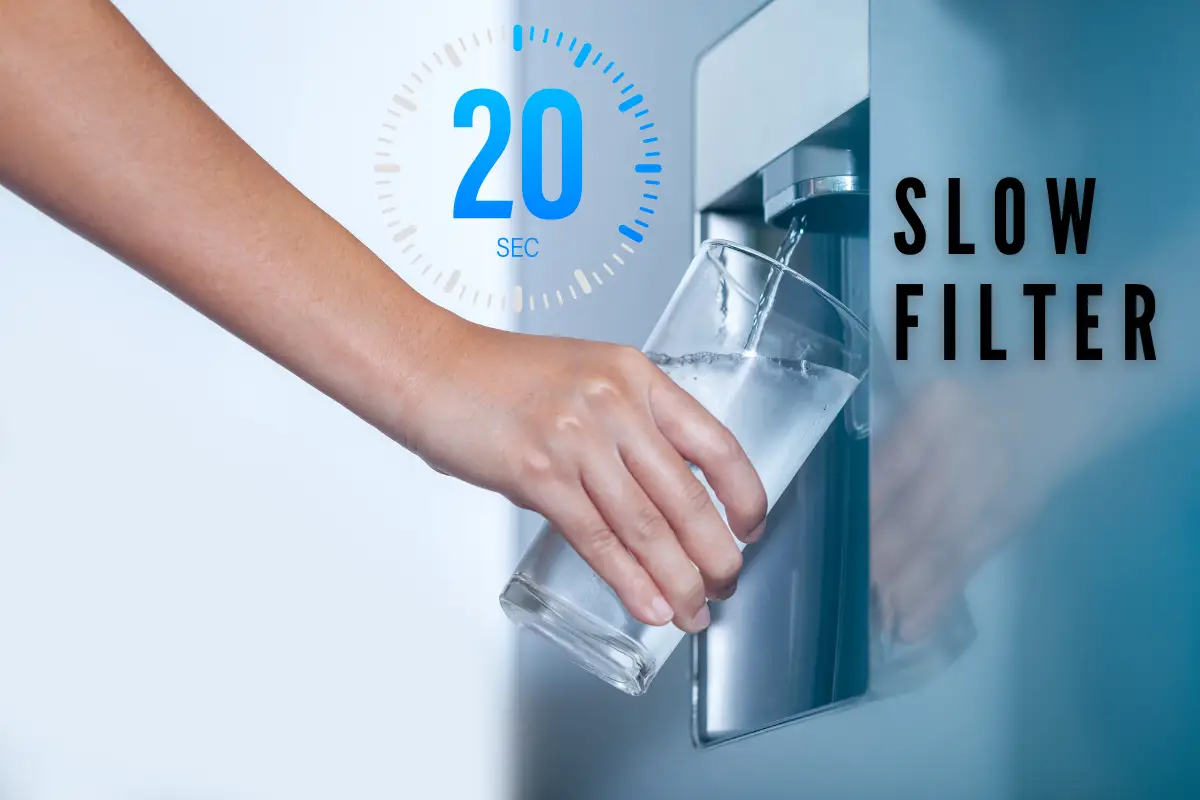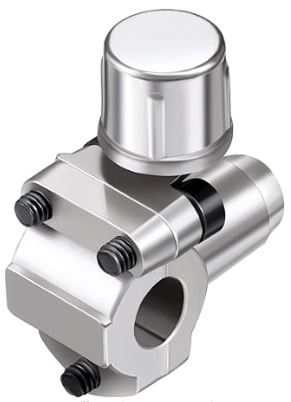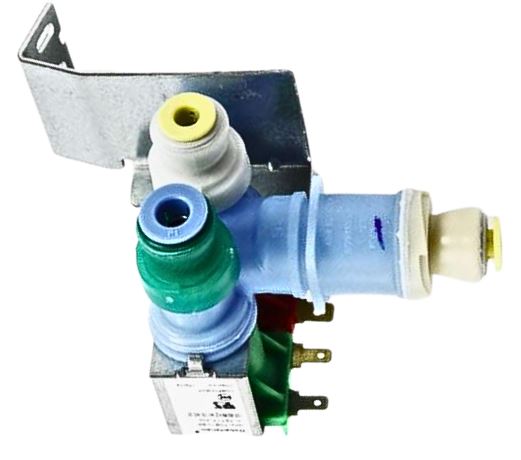Water filters are a necessary part of your refrigerator water dispenser. These filters help to treat and improve the quality of water that flows through your Fridge water dispenser. But if you notice a drop in the water flow rate, your fridge filter is likely the problem.
Your fridge filter may be slow due to a clogged filter, wrongly installed filter, improperly flushed water system, damaged or kinked water line, air pockets, low pressure from a reverse osmosis system, problem with the water inlet valve, no connection of water line to water supply, faulty control board, or a faulty plumbing line.
In this article, we will explain why your fridge filter may be slow and how to fix them.
Reasons Why Your Fridge Filter Is Slow
The average flow rate from a refrigerator water dispenser that has a filter typically ranges from 0.5 to 1.5 gallons per minute (gpm).
This means it should take approximately 7.5 seconds to fill an 8 fl oz glass with water at a flow rate of 0.5 gallons per minute, or 2.5 seconds at a flow rate of 1.5 gallons per minute. So, if you find it takes longer than 7.5 seconds to fill your glass, then you may have a problem with your filter.

1. Clogged filter
A clogged filter is the most reason behind the reduction in water flow rate from fridge dispensers.
As your filter works overtime, it may get clogged with the particles and other contaminants it removes from the water. Hard water, high sediment load or total dissolved solids (TDS) can all play a role in clogging your filter prematurely.
These particles slow down the rate at which water flows through the filter.
Because of this, you should change your fridge filter at least every six months. If your fridge filter has been working for longer than six months, it is most likely clogged and needs a replacement.
A clogged filter will hardly let the water run out of the dispenser. A partially clogged filter will produce a slow and dribbly flow of water.
Test
To check if your filter is clogged, take out the filter and use the dispenser with a filter bypass plug instead. If there is improved water flow, it means either the filter is clogged or incorrectly installed.
Replace Filter
To replace a clogged filter, first, disconnect the refrigerator from its power source. Then locate the filter.
Usually, it could be at the top corner of the refrigerator compartment or the bottom in the base grille below its door. Once you’ve located the filter, remove it.
The method of removing the filter depends on your refrigerator model.
The filter is typically removed by rotating the filter counterclockwise, by pushing the filter in firmly, or by pushing a button to release it.
Firmly replace the old filter with a new one, then plug the fridge back into its power source. Let some water flow through for at least three minutes to flush.
You can leave the water system to operate in bypass mode. This will improve the water flow and ice production.
2. Saddle valve

A refrigerator saddle valve is a device used to connect your fridge to the water supply. It works by piercing a small hole in the water pipe to allow water to flow to the fridge’s ice maker and water dispenser.
Saddle valves are easy to install and don’t require cutting the water line, making them a common choice for DIY refrigerator installations. However, they can have some drawbacks that may affect water flow:
Limited Flow: Saddle valves can reduce the amount of water that flows to your fridge. This can make your ice maker slower and your water dispenser weaker.
Leak Risk: Sometimes, the hole made by the saddle valve doesn’t seal properly, which can lead to water leaks. These leaks can disrupt water flow and cause damage.
Maintenance: These valves might need regular cleaning to prevent clogs that can slow down water flow.
Because of these issues, some experts recommend using a different method to connect your fridge to the water supply. Installing a dedicated water line with the right valve can provide better water flow and reduce the risk of leaks or clogs that might slow down your fridge’s water and ice functions.
3. Water inlet valve

A refrigerator water inlet valve is a critical component of your refrigerator’s water supply system. It’s responsible for controlling the flow of water into the refrigerator’s ice maker and water dispenser.
The minimum pressure required for water inlet valves to work typically ranges from 20 to 30 pounds per square inch (psi). This pressure is necessary to ensure the proper functioning of the valve, allowing it to open and allow water to flow into the refrigerator’s ice maker and water dispenser.
If the water pressure falls below this minimum threshold, the water inlet valve may not open adequately or may not function at all, resulting in reduced or no water flow to the refrigerator. In such cases, it’s essential to address the low water pressure issue by adjusting your home’s water supply system, checking for any blockages or restrictions, and ensuring that the water supply line is in good condition.
4. Incorrect filter installation
A slow fridge filter may not necessarily be because of a fault with the filter itself. It could simply be due to improper installment.
A wrongly installed fridge filter can reduce water flow from the dispenser and ice production from the ice maker.
If you notice the water flow rate has slowed down, or there are air bubbles in the water just after a filter replacement, this is likely to be why.
If you unsure if this is the problem, just try removing it and re-install it and see if the problem goes away.
When replacing a fridge filter yourself, make sure it faces the right way and is firmly in place, not loose.
Consult the instruction manual of your fridge for the proper way to install that fridge filter.
Be careful not to apply too much force when removing the filter because a wrongly installed filter may be a bit difficult to remove.
5. Improperly flushed water system
After installing or replacing a fridge water filter, the water system needs to be flushed.
During the process of filter installation or replacement, air may get into the water system. This air can make the water dispense slowly or drip.
To flush the fridge water system, put a jug under the dispenser. Then, push the dispenser lever or button and let the jug fill up.
Repeat this until the water flow becomes steady.
This process may use up to three to five gallons of water.
6. Damaged or kinked water line
A damaged or kinked water line could be why your fridge dispenser is slow.
Inspect the water line outside your fridge for kinks or damages.
Straighten any kinks you may find. If it is damaged, you may need to call a professional to repair or replace the lines.
7. Air pockets
Air pockets can slow down the rate of water flow from your fridge dispenser.
If you notice spluttering as the water flows out of the dispenser, it may suggest there is some air in the water lines.
To solve this problem, place a jug beneath the dispenser and let water flow out continually. The air will eventually flow out completely, and the spluttering will stop.
8. Using a reverse-osmosis system
Most residential RO systems typically have a flow rate that ranges from 0.5 to 2 gallons per minute (gpm).
If you’re using a reverse osmosis system that goes to your fridge, it could be the reason the water is flowing out slowly, especially if your RO filters also need replacing.
In addition to the reduced water flow, ice cube production will also be affected, causing your refrigerator to dispense small ice cubes.
9. Fault in the control board
Every water dispenser has a control board that regulates its functions. Rarely, a part of, or the whole control board may develop a fault.
Before you think of replacing the control board, first check all other dispenser components.
If the entire dispenser system is not functioning, the board may be the problem and need replacement.
10. Fault in the plumbing line
If you have checked all other options and can’t seem to find the reason behind the slow water flow rate, the problem could be in the plumbing line.
Buildup in the pipes or substandard plumbing may slow down the flow rate of water.
Call a professional to check your plumbing line and replace damaged or clogged pipes. They should also check for and fix any issues in the original plumbing.
How To Unclog A Refrigerator Filter
Here are simple steps to follow to unclog a fridge filter:
- Disconnect the refrigerator from its power source and turn the valve off
- Locate the filter and remove it
- Tap it over a garbage can to dislodge any excess particle buildup from it
- Submerge it in warm water containing vinegar, dish soap, or a cleaning product that is specifically for cleaning water filters. Let the filter soak for 30 minutes
- Rinse the filter under running water until the water flowing turns clear. Make sure you rinse thoroughly so that all traces of the cleaning agents are gone.
- Leave to air dry and then secure it back in its place
- Reconnect the refrigerator to its power source and turn the valve on.
- Flush the filter for about 3 minutes.
Why is my refrigerator filter clogging so fast?
Fridge filters can get clogged quickly because of these reasons:
- Too much sediment in the water supply, entering and clogging up the filter – installing a whole house sediment filter can be a good option in these instances.
- Not changing the filter often.
- Hard water – calcium and magnesium deposits will rapidly clog a fridge filter, especially if you live in an area with hard water.
